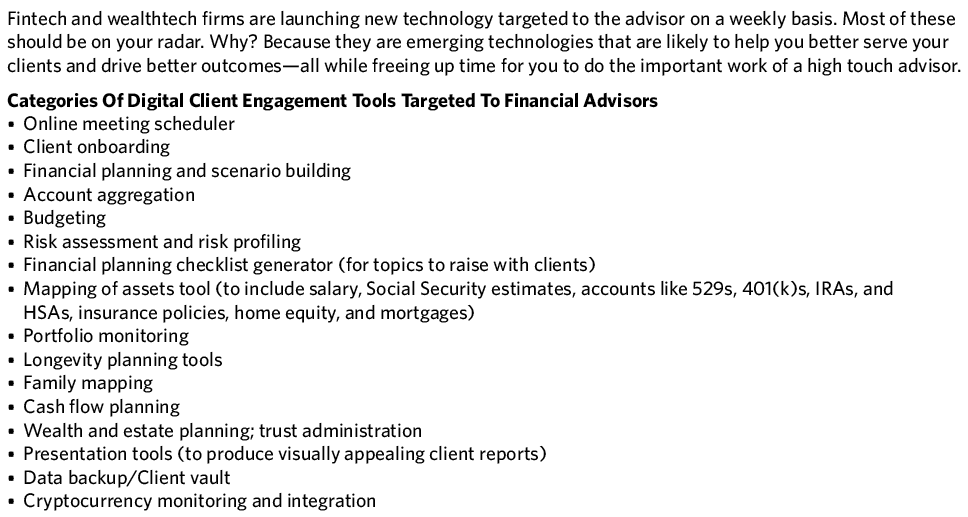Are these changes on our doorstep? “Yes. Some firms have it today,” says Sharry, noting the complexity and the capital required to build these new integrated, coordinated UMH ecosystems happens over time. “However, the big change on the horizon will be leveraging tech to make the portfolio management process more comprehensive. This is big and will transform our industry.”
Sharry shared an example: Bain Capital recently made a big investment in the Carson Group, one of the largest RIAs. The valuation equated to 6% of AUM, a record high valuation. It’s representative of what’s driving the build out of UMH platforms. That level of valuation presumes Carson will be doing more and more of the asset management, while the advisor will be doing less and less. The advisor will focus more on relationship management, handholding and client and asset acquisition and retention.

Engaging Advisors To Adopt New Tech Across The Enterprise
“The wealth management industry is now discovering tech, but how do you do it productively?” That’s one the key questions beings asked by industry leaders and Next Chapter advisor members like Kabir Sethi, head of Digital Wealth Management at Merrill Lynch.
“Sure, you can start with support from senior management and their strategic focus on technology,” says Sethi. “But you can’t assume that just because you put new technology out there, people will use it. Most advisors operate in their comfort zone. But that needs to change,” he suggests.
“At our firm, we understand there is no substitute for hand-to-hand combat and equipping field leadership with the right tools and knowledge. That means that we as senior leaders are required to put ourselves in the shoes of the advisors in the field. We have 19,000 advisors and over time, we have built a regional team of over 40 digital specialists who are separate from the practice management team and focus on coaching advisors as they evolve to a digital operating model over time,” Sethi explains.
Jack Sharry recommends a “nudge or micro engagement strategy” to boost adoption of tools. “You can’t overwhelm people with too much technology all at once. If you give them a specific new tool to use, such as an RMD tool, or a Roth conversion tool, if you can clearly communicate the benefits of each tool and show how it can save the advisor time and lead their client to the next best action, then you’ve hit a home run,” says Sharry.
Lastly on adoption, what is the role of direct incentives for advisor/staff adoption of technologies? Should people expect to be compensated in some fashion?
Focus Financial, which partners with 55 RIAs, uses game and reward-based systems to drive technology adoption. One technique they discovered was only enabling 20% of the functionality in new software to start, then adding more in successive phases. This helps avoid overwhelming advisors who usually don’t have time for long training sessions.
Challenges Of Integration: Out With The Old?
In technology, it’s often a question of old vs. new. The old tech is dated, but at least people know how to use it to get the job done. The new tech holds the promise of efficiency and boosting productivity, but may require lots of change, training and time away from clients.
“Even when there’s a path for integration, the blending of old and new is more complex when some of the old is proprietary and not easily integrated,” says Jud Mackrill of Milemarker.








